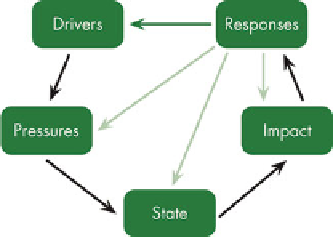Environmental Engineering Reference
In-Depth Information
20.2.1.3 The Driver, Pressure, State, Impact and Response (DPSIR)
Framework
From an environmental policy setting perspective the
Driver, Pressure, State,
Impact and Response
(DPSIR) framework is important. This framework, shown in
Fig.
20.3
, is a system for analysing. The
Drivers
forces responsible for change such
as industrialisation, growing population. These cause
Pressures
such as increasing
soil sealing, which affect the
State
of the environment, for example reduced abil-
ity to store rainfall. The result of this are
Impacts
such as greater risk of flooding
,
to which Society may need to make a
Response
. Indicators can describe the state
of sustainability (e.g. the health of the population); pressures on sustainability (e.g.
emissions of contaminants); responses to problems (e.g. % of remediation projects
involving soil re-use); and contexts that decision-makers have little control over
(e.g. population structure). The DPSIR concept can also be extended to economic
and social indicators (Therivel
2004
).
Therivel (
2004
) points out that most indicator lists include a combination of state,
pressure, response and context indicators with the aim of producing a full “picture”
of sustainability as possible. Indicator sets are not often explicit about what DPSIR
segments they relate to, and as many are mixed there is a possibility of double
counting factors. For example, one indicator might be the number of heavy goods
vehicle (HGV) miles travelled for a particular remediation project, whilst another
might be concerned with global air quality considering NO
x
and SO
x
across the
project (
State)
. However, HGV movements and HGV exhausts are a source of NO
x
and SO
x
(
Pressure
) so there appears to be double counting in the indicator set. One
way of dealing with double counting is to strip down the number of indicators so that
only one type of indicator, e.g.
State
and limiting the assessments made to a number
of key criteria, e.g. “air quality” as determined by NO
x
and SO
x
measurements.
This is the type of approach that might be adopted for a Life Cycle Assessment type
of appraisal. However, this
reductionist approach
has some major disadvantages as
shown below.
HGV miles measures more than simply air quality. It includes a rich mixture of
impacts on the environment, but also on society (e.g. road safety, noise, disturbance)
and economics (fuel costs, costs related to traffic congestion caused). It has a par-
ticular and unique characteristic which may be of interest to decision makers. It is
Fig. 20.3
DPSIR Model

Search WWH ::

Custom Search